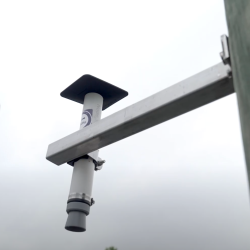Big Questions In Science- 10) How can we improve weather forecasting?
It may have been one of the biggest natural disasters to strike the East Coast, but Superstorm Sandy was also a scientific triumph of numerical weather prediction, says Distinguished University Professor Eugenia Kalnay, a world-renowned expert in numerical weather prediction (NWP) in the Department of Atmospheric and Oceanic Science. “I’m quite impressed by the operational forecasts of Sandy,” she says. “The precipitation, the winds and even the estimation of the uncertainty of the forecasts—they were all impressively accurate.”
This accuracy is due, in part, to Kalnay’s own work over the past 30 years. At the National Weather Service (NWS) from 1987 to 1997, she headed the research division that develops the computer atmospheric models and the methods for “assimilating observations” used for forecasting the weather. “Our seven-day forecast is now about as accurate as a one or two-day forecast was in the 1960s,” she notes. Still, weather prediction is difficult as evidenced by the storm that started in Iowa on June 29, 2012, and evolved into a “derecho” that moved eastward for more than 12 hours with very severe weather all the way to the Washington, D.C. region, leaving behind widespread devastation and power outages. Although the NWS Storm Prediction Center issued severe thunderstorm warnings along the route, further improvements in NWP means future warnings could be provided days, not hours, in advance.
One of the keys to improving weather forecasts is to ensure that atmospheric computer models start with an accurate estimate of current atmospheric conditions. As an expert on “data assimilation,” Kalnay develops methods to better determine initial conditions generated from observations, such as satellite and radar information. Researchers and students worldwide use her book, Atmospheric Modeling, Data Assimilation and Predictability, which has been translated into Chinese and Korean.
Kalnay and Distinguished University Professor James Yorke founded the college’s Weather & Chaos group, which has made groundbreaking improvements in data assimilation systems and numerical weather prediction, graduating some 20 doctoral experts in the process. Kalnay is also a pioneer in ensemble forecasting, a technique that she developed and implemented operationally 20 years ago at the NWS. “Instead of making a single forecast, we use slightly different initial conditions and create an ensemble of 20 forecasts,” she explains. “This way, we can predict forecast uncertainty by examining where these weather forecasts agree or disagree, making them much more useful.” The introduction of this information extended forecasts from three to seven days beginning in the mid 1990s. More recently, the ensemble approach has been combined with data assimilation in the Local Ensemble Transform Kalman Filter, a method developed by Brian Hunt, a professor in the Weather & Chaos group, and adopted by several countries for operational weather prediction. In the future, the approaches could have other important applications as well. “The ideas of ensemble prediction and data assimilation could be adopted to improve forecasts of other types, such as economic forecasts,” adds Kalnay.
Writer: Beth Panitz







